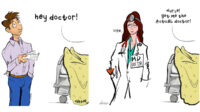If you’ve been keeping up with our 3-part series on doctors and their well-being, you’ll remember in Part I we focused on doctors and sleep, and in Part II we focused on doctors and exercise, now we have the final piece to round out our research. At any given time, no more than 2-4% of healthcare professionals at any level regularly engage in disruptive behavior. But when they do, it can pose a threat to patient and provider safety.
The American Medical Association defines disruptive physician behavior (DPB) as “personal conduct, verbal or physical that has the potential to negatively affect patient care or the ability to work with other members of the healthcare team.” The Joint Commission broadens the definition to include “all behaviors that undermine a culture of safety. Both bodies have issued policy statements acknowledging that DPB may pose a threat to patient and provider safety. In fact, the Joint Commission considers DPB to be such a serious matter that in 2008 it issued a sentinel event alert calling attention to the problem.
It’s a classic snowball effect of abuse. The Agency for Healthcare Research and Quality (AHRQ) aptly describes it as an “authority gradient”. It’s worth reading their description of exactly how DPB poses a threat to patient and provider safety:
“Fundamentally, disruptive behavior by individuals subverts the organization’s ability to develop a culture of safety. Two of the central tenets of a safe culture are directly threatened by disruptive behavior:
- Teamwork across disciplines
- A blame-free environment for discussing safety issues
“An environment in which frontline caregivers are frequently demeaned or harassed reinforces a steep authority gradient and contributes to poor communication, in turn reducing the likelihood of errors being reported or addressed. Indeed, a workplace culture that tolerates demeaning or insulting behavior is likely to be one in which workers are ‘named, blamed and shamed’ for making an error.”
The Question Is: What Causes Disruptive Physician Behavior?
Much study and research has been dedicated to answering that question, only to find that it “all depends”. The questions about the root causes of disruptive physician behavior are:
- Is it a matter of tolerating such behavior in medical school, churning out only those who can survive it (and give it)?
- Is it is a matter of stress, substance abuse, and mental health issues?
- Or is it simply a matter of physicians who are influential, powerful and not accustomed to being challenged or questioned about their behavior?
As we noted at the beginning, only 2-4% of physicians at any time exhibit DPB but when they do, they make life intolerable for the team and risky for the patient.
DPB is Rooted in Insecurity and Immaturity
When the Journal of Hospital Medicine published a study on disruptive physician behavior, they called the etiology of the behavior “multifactorial and complex”, ranging from psychopathology to unhealthy modeling during training. The study says the external and internal factors that can contribute to the behavior include:
- External stressors and negative experiences–professional and/or personal
- Overwork and fatigue
- Fatigue
- Strife
- Mental health problems as the result of dysfunctional home and work environments
- Burnout
- Depression
- Lack of emotional intelligence
- Poor social skills
- Cultural and ethnic issues
- Generation and gender bias
However, contrary to generally held opinion, so-called “maladaptive” coping strategies including the use of illegal substances, drug and/or alcohol dependence are not frequent causes of disruptive physician behavior. The study says that fewer than 10 percent of disruptive physician behavior issues are related to substance abuse. Instead, disruptive physician behavior (DPB) is linked to an individual’s “character, values, perceptions, and attitudes”.
Clearly, the study does not suffer fools gladly. The authors do not give any quarter to the “usual suspects” who exhibit DPB, namely influential physicians who bring boatloads of volume and procedural dollars into a healthcare organization, and who are unaccustomed to being questioned. Instead, the study says, “Individuals who engage in DPB typically lack insight and justify their behaviors as a means to achieve a goal. Disrespectful behavior is rooted, in part, in characteristics such as insecurity, immaturity, and aggressiveness; however, it can also be learned, tolerated, and reinforced in the hierarchical hospital culture.”
We didn’t relay examples of DPB here because if you are a medical student, resident or physician you have witnessed it. You know all too well what it is. The only way to change a culture is to be the change, even though that is a well-worn cliche. Resist DPB at all costs and you will find that your patients rely on you and your colleagues trust you. You will also avoid being named in a sentinel event, appearing before the executive committee and potentially losing your right to practice in your healthcare organization.
Our thesis in this three-part series was that lack of sleep, good nutrition and exercise might contribute to poor physician behavior. As you can see, we were wrong. But, all journeys teach something and this one has delivered a most worthwhile lesson. The moral of the story here is that despite your level of success or influence, there is no excuse to stand at the top of the authority gradient and rain abuse down on those around you. Although there are plenty of physicians who exhibit it, in reality, medicine has no room for abuse and risky behavior. There is no room for those who are centered solely on themselves and have forgotten the purpose of medicine; to focus on those who are ill, injured and in need of healing.




